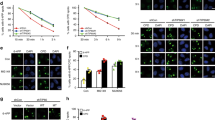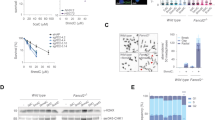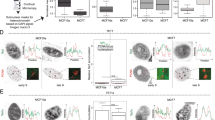Abstract
Flap endonuclease 1 (FEN1), a structure-specific endo- and exonuclease, has multiple functions that determine essential biological processes, such as cell proliferation and cell death. As such, the enzyme must be precisely regulated to execute each of its functions with the right timing and in a specific subcellular location. Here we report that FEN1 is methylated at arginine residues, primarily at Arg192. The methylation suppresses FEN1 phosphorylation at Ser187. The methylated form, but not the phosphorylated form, of FEN1 strongly interacts with proliferating cell nuclear antigen (PCNA), ensuring the 'on' and 'off' timing of its reaction. Mutations of FEN1 disrupting arginine methylation and PCNA interaction result in unscheduled phosphorylation and a failure to localize to DNA replication or repair foci. This consequently leads to a defect in Okazaki fragment maturation, a delay in cell cycle progression, impairment of DNA repair and a high frequency of genome-wide mutations.
This is a preview of subscription content, access via your institution
Access options
Subscribe to this journal
Receive 12 print issues and online access
$259.00 per year
only $21.58 per issue
Buy this article
- Purchase on Springer Link
- Instant access to full article PDF
Prices may be subject to local taxes which are calculated during checkout






Similar content being viewed by others
References
Shen, B. et al. Multiple but dissectible functions of FEN-1 nucleases in nucleic acid processing, genome stability and diseases. Bioessays 27, 717–729 (2005).
Qiu, J., Li, X., Frank, G. & Shen, B. Cell cycle-dependent and DNA damage-inducible nuclear localization of FEN-1 nuclease is consistent with its dual functions in DNA replication and repair. J. Biol. Chem. 276, 4901–4908 (2001).
Shibata, Y. & Nakamura, T. Defective flap endonuclease 1 activity in mammalian cells is associated with impaired DNA repair and prolonged S phase delay. J. Biol. Chem. 277, 746–754 (2002).
Guo, Z. et al. Nucleolar localization and dynamic roles of flap endonuclease 1 in ribosomal DNA replication and damage repair. Mol. Cell. Biol. 28, 4310–4319 (2008).
Liu, P. et al. Removal of oxidative DNA damage via FEN1-dependent long-patch base excision repair in human cell mitochondria. Mol. Cell. Biol. 28, 4975–4987 (2008).
Zheng, L. et al. Human DNA2 is a mitochondrial nuclease/helicase for efficient processing of DNA replication and repair intermediates. Mol. Cell 32, 325–336 (2008).
Kalifa, L., Beutner, G., Phadnis, N., Sheu, S.S. & Sia, E.A. Evidence for a role of FEN1 in maintaining mitochondrial DNA integrity. DNA Repair (Amst.) 8, 1242–1249 (2009).
Wu, X. et al. Processing of branched DNA intermediates by a complex of human FEN-1 and PCNA. Nucleic Acids Res. 24, 2036–2043 (1996).
Guo, Z. et al. Comprehensive mapping of the C-terminus of flap endonuclease-1 reveals distinct interaction sites for five proteins that represent different DNA replication and repair pathways. J. Mol. Biol. 377, 679–690 (2008).
Chen, U., Chen, S., Saha, P. & Dutta, A. p21Cip1/Waf1 disrupts the recruitment of human Fen1 by proliferating-cell nuclear antigen into the DNA replication complex. Proc. Natl. Acad. Sci. USA 93, 11597–11602 (1996).
Li, X., Li, J., Harrington, J., Lieber, M.R. & Burgers, P.M. Lagging strand DNA synthesis at the eukaryotic replication fork involves binding and stimulation of FEN-1 by proliferating cell nuclear antigen. J. Biol. Chem. 270, 22109–22112 (1995).
Zheng, L., Dai, H., Qiu, J., Huang, Q. & Shen, B. Disruption of the FEN-1/PCNA interaction results in DNA replication defects, pulmonary hypoplasia, pancytopenia, and newborn lethality in mice. Mol. Cell. Biol. 27, 3176–3186 (2007).
Levin, D.S., McKenna, A.E., Motycka, T.A., Matsumoto, Y. & Tomkinson, A.E. Interaction between PCNA and DNA ligase I is critical for joining of Okazaki fragments and long-patch base-excision repair. Curr. Biol. 10, 919–922 (2000).
Zheng, L. et al. Novel function of the flap endonuclease 1 complex in processing stalled DNA replication forks. EMBO Rep. 6, 83–89 (2005).
Parrish, J.Z., Yang, C., Shen, B. & Xue, D. CRN-1, a Caenorhabditis elegans FEN-1 homologue, cooperates with CPS-6/EndoG to promote apoptotic DNA degradation. EMBO J. 22, 3451–3460 (2003).
Hasan, S. et al. Regulation of human flap endonuclease-1 activity by acetylation through the transcriptional coactivator p300. Mol. Cell 7, 1221–1231 (2001).
Henneke, G., Koundrioukoff, S. & Hubscher, U. Phosphorylation of human Fen1 by cyclin-dependent kinase modulates its role in replication fork regulation. Oncogene 22, 4301–4313 (2003).
McBride, A.E. & Silver, P.A. State of the arg: protein methylation at arginine comes of age. Cell 106, 5–8 (2001).
Bedford, M.T. & Richard, S. Arginine methylation an emerging regulator of protein function. Mol. Cell 18, 263–272 (2005).
Bedford, M.T. & Clarke, S.G. Protein arginine methylation in mammals: who, what, and why. Mol. Cell 33, 1–13 (2009).
Weber, S. & Bauer, U.M. Arginine methylation in interferon signaling: new light on an old story. Cell Cycle 8, 1464–1465 (2009).
Boisvert, F.M., Hendzel, M.J., Masson, J.Y. & Richard, S. Methylation of MRE11 regulates its nuclear compartmentalization. Cell Cycle 4, 981–989 (2005).
Adams, M.M. et al. 53BP1 oligomerization is independent of its methylation by PRMT1. Cell Cycle 4, 1854–1861 (2005).
Jansson, M. et al. Arginine methylation regulates the p53 response. Nat. Cell Biol. 10, 1431–1439 (2008).
El-Andaloussi, N. et al. Arginine methylation regulates DNA polymerase beta. Mol. Cell 22, 51–62 (2006).
El-Andaloussi, N. et al. Methylation of DNA polymerase beta by protein arginine methyltransferase 1 regulates its binding to proliferating cell nuclear antigen. FASEB J. 21, 26–34 (2007).
Boisvert, F.M., Dery, U., Masson, J.Y. & Richard, S. Arginine methylation of MRE11 by PRMT1 is required for DNA damage checkpoint control. Genes Dev. 19, 671–676 (2005).
Boisvert, F.M., Rhie, A., Richard, S. & Doherty, A.J. The GAR motif of 53BP1 is arginine methylated by PRMT1 and is necessary for 53BP1 DNA binding activity. Cell Cycle 4, 1834–1841 (2005).
Liu, Q. & Dreyfuss, G. In vivo and in vitro arginine methylation of RNA-binding proteins. Mol. Cell. Biol. 15, 2800–2808 (1995).
Chen, D.H., Wu, K.T., Hung, C.J., Hsieh, M. & Li, C. Effects of adenosine dialdehyde treatment on in vitro and in vivo stable protein methylation in HeLa cells. J. Biochem. 136, 371–376 (2004).
Mostaqul Huq, M.D. et al. Suppression of receptor interacting protein 140 repressive activity by protein arginine methylation. EMBO J. 25, 5094–5104 (2006).
Weber, S. et al. PRMT1-mediated arginine methylation of PIAS1 regulates STAT1 signaling. Genes Dev. 23, 118–132 (2009).
Tishkoff, D.X., Filosi, N., Gaida, G.M. & Kolodner, R.D. A novel mutation avoidance mechanism dependent on S. cerevisiae RAD27 is distinct from DNA mismatch repair. Cell 88, 253–263 (1997).
Soza, S. et al. DNA ligase I deficiency leads to replication-dependent DNA damage and impacts cell morphology without blocking cell cycle progression. Mol. Cell. Biol. 29, 2032–2041 (2009).
Whitfield, M.L. et al. Stem-loop binding protein, the protein that binds the 3′ end of histone mRNA, is cell cycle regulated by both translational and post-translational mechanisms. Mol. Cell. Biol. 20, 4188–4198 (2000).
Yamagata, K. et al. Arginine methylation of FOXO transcription factors inhibits their phosphorylation by Akt. Mol. Cell 32, 221–231 (2008).
Almeida, K.H. & Sobol, R.W. A unified view of base excision repair: lesion-dependent protein complexes regulated by post-translational modification. DNA Repair (Amst.) 6, 695–711 (2007).
Yang, X.J. Multisite protein modification and intramolecular signaling. Oncogene 24, 1653–1662 (2005).
Déry, U. et al. A glycine-arginine domain in control of the human MRE11 DNA repair protein. Mol. Cell. Biol. 28, 3058–3069 (2008).
Tom, S., Henricksen, L.A. & Bambara, R.A. Mechanism whereby proliferating cell nuclear antigen stimulates flap endonuclease 1. J. Biol. Chem. 275, 10498–10505 (2000).
Le Romancer, M. et al. Regulation of estrogen rapid signaling through arginine methylation by PRMT1. Mol. Cell 31, 212–221 (2008).
Wang, Y. et al. Human PAD4 regulates histone arginine methylation levels via demethylimination. Science 306, 279–283 (2004).
Cuthbert, G.L. et al. Histone deimination antagonizes arginine methylation. Cell 118, 545–553 (2004).
Chang, B., Chen, Y., Zhao, Y. & Bruick, R.K. JMJD6 is a histone arginine demethylase. Science 318, 444–447 (2007).
Frietze, S., Lupien, M., Silver, P.A. & Brown, M. CARM1 regulates estrogen-stimulated breast cancer growth through up-regulation of E2F1. Cancer Res. 68, 301–306 (2008).
Cheung, N., Chan, L.C., Thompson, A., Cleary, M.L. & So, C.W. Protein arginine-methyltransferase-dependent oncogenesis. Nat. Cell Biol. 9, 1208–1215 (2007).
Mitra, A.K. et al. Association of polymorphisms in base excision repair genes with the risk of breast cancer: a case-control study in North Indian women. Oncol. Res. 17, 127–135 (2008).
Lu, R. & Serrero, G. Inhibition of PC cell-derived growth factor (PCDGF, epithelin/granulin precursor) expression by antisense PCDGF cDNA transfection inhibits tumorigenicity of the human breast carcinoma cell line MDA-MB-468. Proc. Natl. Acad. Sci. USA 97, 3993–3998 (2000).
Szczesny, B., Tann, A.W., Longley, M.J., Copeland, W.C. & Mitra, S. Long patch base excision repair in mammalian mitochondrial genomes. J. Biol. Chem. 283, 26349–26356 (2008).
Qian, Y. et al. Molecular events after antisense inhibition of hMSH2 in a HeLa cell line. Mutat. Res. 418, 61–71 (1998).
Acknowledgements
We thank G. Tsaprailis in the Proteomics Core facility of University of Arizona for technical assistance in determining the methylation sites on FEN1. We thank S.R. da Costa for editorial assistance. This work was supported by US National Institutes of Health grants RO1 CA073764 and R01CA085344 to B.S.
Author information
Authors and Affiliations
Contributions
Z.G., L.Z. and B.S. designed the experiments, analyzed the data and wrote the manuscript. H.X. purified recombinant proteins. H.D., M.Z. and M.R.P. performed cell biological experiments. Q.M.C. performed the experiments with mass spectrometry and analyzed the data.
Corresponding author
Ethics declarations
Competing interests
The authors declare no competing financial interests.
Supplementary information
Supplementary Text and Figures
Supplementary Figures 1–12, Supplementary Tables 1 and 2, Supplementary Methods (PDF 1664 kb)
Rights and permissions
About this article
Cite this article
Guo, Z., Zheng, L., Xu, H. et al. Methylation of FEN1 suppresses nearby phosphorylation and facilitates PCNA binding. Nat Chem Biol 6, 766–773 (2010). https://doi.org/10.1038/nchembio.422
Received:
Accepted:
Published:
Issue Date:
DOI: https://doi.org/10.1038/nchembio.422
This article is cited by
-
PRMT1 in human neoplasm: cancer biology and potential therapeutic target
Cell Communication and Signaling (2024)
-
Methylation of BRD4 by PRMT1 regulates BRD4 phosphorylation and promotes ovarian cancer invasion
Cell Death & Disease (2023)
-
Emerging posttranslational modifications and their roles in DNA damage response
Genome Instability & Disease (2023)
-
The role of protein arginine methylation 5 in DNA damage repair and cancer therapy
Genome Instability & Disease (2023)
-
Protein arginine methyltransferases: promising targets for cancer therapy
Experimental & Molecular Medicine (2021)



